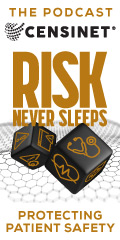Curbside Consult with Dr. Jayne 5/6/19
National Nurses Week is May 6-12 and I want to send a shout-out to all the nurses out there. I’ve worked with some phenomenal nurse informaticists over the years. Their perspective often varies from that of physicians and their input has been invaluable on numerous projects.
I’m also grateful to the clinical nurses who have had my back, whether it was in medical school, residency, or when trying to implement EHRs. Nurses have helped me formulate strategies to get physicians on board because they understand how clinical departments operate in ways that an administrator might not fully grasp.
We walk a lot about physician burnout, but we don’t always talk about nursing burnout as much as we should. Many nurses from my hospital have left traditional nursing and are instead working in fields such as administration, telehealth, case management, or with payers. One of my close friends became an elementary school nurse and another does case review for attorneys. In an anecdotal survey of why they left the patient care trenches, the top reasons include stress, unpredictable hours, and inadequate work-life balance. One who worked with me in the emergency department was mainly afraid of workplace violence, having been involved in several altercations involving patients or upset family members.
I had the opportunity recently to attend a seminar on workplace violence, which is something all of us that spend time in hospitals need to think about. Medical settings are the most common location for workplace violence. According to the Bureau of Labor Statistics, more than 70% of all workplace assaults happen in the healthcare and social services industry. Potential causes include the idea that healthcare has become less patient-focused and less personal; wait times have become longer; patients have unmet expectations; prescription drug abuse; and lack of mental health support services. Even with those facts, organizations tend to provide little education on how to de-escalate tense situations or how to respond when a violent episode occurs.
The seminar recommended that clinical staff receive formal training in spotting behaviors that could lead to violence and in learning how to manage situations so that they don’t escalate. Practices, nursing units, and facility departments should develop detailed procedures for addressing violent situations, including how to protect patients and themselves. They also recommended training in how to best interact with law enforcement should a violent episode occur. Last, they discussed conducting drills to test those procedures, much like an organization would have an EHR downtime drill or a mass-casualty drill. Although we hear a lot about intruder drills in the schools, we don’t hear a lot about them in healthcare settings. The speakers advocated the Run-Hide-Fight response to active shooter incidents, and I could tell these were new concepts for most of the people in the audience.
The majority of the seminar was spent on strategies for preventing violent encounters in the first place. We were encouraged to look for patients or family members with depressed mood, bizarre behavior, and changes in personality. These are readily identifiable by most healthcare professionals, along with findings such as paranoid ideations and delusional statements. Those were fairly subtle, but actual threats of violence also made the list of items that should trigger de-escalation maneuvers.
They went on to recommend that healthcare workplace training programs include situational awareness training during the onboarding process with annual refreshers. I would think that situational awareness would be one of the hardest skills to master in the healthcare setting since we often need to be laser-focused on the patient in front of us. We might not be aware of incidents occurring in adjacent patient rooms or at the clinical workstation.
When the situation is unfolding in front of us, clinical workers are encouraged to allow patients to verbally vent while showing empathy and understanding. If the situation deteriorates, we need to be able to alert others or get help; identify escape routes; and plan for self-defense. Like law enforcement teams, we were reminded to never turn our backs on potentially violent patients or family members.
The seminar also covered strategies for prevention that are fairly straightforward, such as securing doors, limiting non-employee access to critical areas of the facility, installing proper lighting in the parking lot, and changing door codes often if electronic locks are in place. Staff should wear name badges so they can be easily identified as belonging in key areas. The speakers also discussed the practice of “see something, say something” where everyone is empowered to bring attention to situations that might become problematic.
I’ve been in some tense situations and have encountered violent patients, but I’ve never personally experienced the types of violence that was discussed during several of the case studies. We were asked to role play various scenarios, including custody disputes, disgruntled employees, and unstable patients. We were challenged to create a draft emergency operation plan for our facility with ideas for policies and procedures on how to address various types of workplace violence.
Several of us had the most difficulty figuring out how we would protect patients as well as staff members, particularly if patients were immobile or critically ill. We talked about campus lockdowns and how to quickly alert patients and visitors to stay away from the facility if needed. We also talked about how to care for potential victims. Hospitals and emergency departments have different resources than ambulatory practices and we brainstormed ways to use the supplies on hand for different eventualities.
The last part of the course dealt with how to behave in an active shooter situation when law enforcement arrives. Especially if SWAT or other specialized resources are involved, those resources are trained to proceed in ways that might not seem intuitive to healthcare providers. Officers aren’t going to stop and render aid to wounded individuals until they are certain the threat has been stopped. They might treat everyone present as a potential threat while they gain control of the situation.
After the course, I was curious whether any of my friends that work for EHR vendors and routinely assist clients in healthcare locations had received any kind of training on workplace violence. Although my survey sample was small, no one had received any kind of training in workplace violence.
I’d be curious to hear how large technology vendors handle this and whether they provide formal training for staff members. Similarly, for hospitals and provider organizations, what’s your strategy? Leave a comment or email me.

Email Dr. Jayne.





















































































Nice article, but every time I saw the word "provider" (24 times), I felt demeaned. We are not "providers". How…